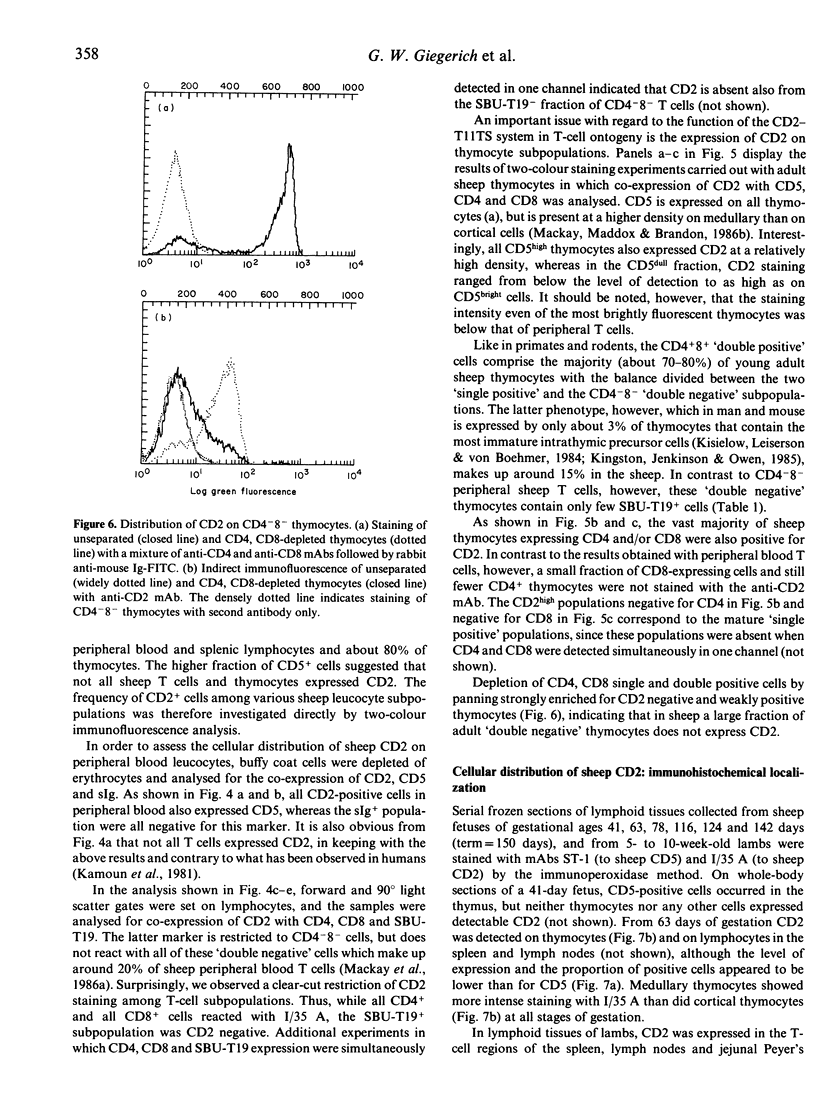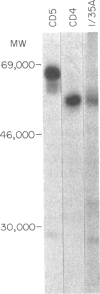Abstract
A monoclonal antibody (mAb) generated against sheep T-cell blasts, called I/35 A, blocks sheep autologous E rosetting and competes with purified T11 target structure (TS), the sheep form of LFA3, for binding sites on the sheep T-cell surface. Immunoprecipitation from lysates of surface iodinated sheep T cells identifies the cell surface molecule recognized by mAb I/35 A as a single chain polypeptide migrating as a diffuse band of MW 55,000. From its binding properties and the biochemical nature of the target antigen, we conclude that mAb I/35 A is directed at sheep CD2. This finding makes sheep the first animal model in which the CD2-LFA3 (T11TS) system is defined by mAbs to both receptor and ligand. When analysed by two-colour flow cytometry and by immunohistochemistry, the cellular expression of CD2 in sheep differs significantly to that reported in humans. In peripheral blood, CD2 is found exclusively on CD4+8- and CD4-8+ T cells, while the third, CD4-8- (predominantly SBU-T19+) subset of sheep T cells (around 20% in peripheral blood) is CD2-. In thymus, only low to moderate levels of CD2 expression occurs on 80% of cells. Among these, medullary 'single positive' thymocytes express the highest level of CD2, whereas the CD4-8- 'double negative' population (which in contrast to peripheral CD4-8- T cells contains only very few SBU-T19+ cells) consists of CD2- and weakly positive cells. In peripheral lymphoid organs, CD2+ lymphocytes occur in the T-cell regions of spleen, lymph nodes and jejunal Peyer's patches (JPP). Tissue macrophages found in B-cell follicles of lymph nodes and JPP are also CD2+. The implications of these findings are discussed in terms of the role CD2 plays in the proliferation of immature thymocytes and of the possible importance of CD2/LFA3 interactions in lymphocyte recirculation.
Full text
PDF







Images in this article
Selected References
These references are in PubMed. This may not be the complete list of references from this article.
- Bierer B. E., Peterson A., Barbosa J., Seed B., Burakoff S. J. Expression of the T-cell surface molecule CD2 and an epitope-loss CD2 mutant to define the role of lymphocyte function-associated antigen 3 (LFA-3) in T-cell activation. Proc Natl Acad Sci U S A. 1988 Feb;85(4):1194–1198. doi: 10.1073/pnas.85.4.1194. [DOI] [PMC free article] [PubMed] [Google Scholar]
- Brenner M. B., McLean J., Dialynas D. P., Strominger J. L., Smith J. A., Owen F. L., Seidman J. G., Ip S., Rosen F., Krangel M. S. Identification of a putative second T-cell receptor. Nature. 1986 Jul 10;322(6075):145–149. doi: 10.1038/322145a0. [DOI] [PubMed] [Google Scholar]
- Ceredig R., Dialynas D. P., Fitch F. W., MacDonald H. R. Precursors of T cell growth factor producing cells in the thymus: ontogeny, frequency, and quantitative recovery in a subpopulation of phenotypically mature thymocytes defined by monoclonal antibody GK-1.5. J Exp Med. 1983 Nov 1;158(5):1654–1671. doi: 10.1084/jem.158.5.1654. [DOI] [PMC free article] [PubMed] [Google Scholar]
- Dustin M. L., Sanders M. E., Shaw S., Springer T. A. Purified lymphocyte function-associated antigen 3 binds to CD2 and mediates T lymphocyte adhesion. J Exp Med. 1987 Mar 1;165(3):677–692. doi: 10.1084/jem.165.3.677. [DOI] [PMC free article] [PubMed] [Google Scholar]
- Ezaki T., Miyasaka M., Beya M. F., Dudler L., Trnka Z. A murine anti-sheep T8 monoclonal antibody, ST-8, that defines the cytotoxic T lymphocyte population. Int Arch Allergy Appl Immunol. 1987;82(2):168–177. doi: 10.1159/000234183. [DOI] [PubMed] [Google Scholar]
- Haynes B. F., Dowell D. L., Hensley L. L., Gore I., Metzgar R. S. Human T cell antigen expression by primate T cells. Science. 1982 Jan 15;215(4530):298–300. doi: 10.1126/science.6171885. [DOI] [PubMed] [Google Scholar]
- Hünig T., Mitnacht R., Tiefenthaler G., Köhler C., Miyasaka M. T11TS, the cell surface molecule binding to the "erythrocyte receptor" of T lymphocytes: cellular distribution, purification to homogeneity and biochemical properties. Eur J Immunol. 1986 Dec;16(12):1615–1621. doi: 10.1002/eji.1830161223. [DOI] [PubMed] [Google Scholar]
- Hünig T. The cell surface molecule recognized by the erythrocyte receptor of T lymphocytes. Identification and partial characterization using a monoclonal antibody. J Exp Med. 1985 Sep 1;162(3):890–901. doi: 10.1084/jem.162.3.890. [DOI] [PMC free article] [PubMed] [Google Scholar]
- Hünig T., Tiefenthaler G., Meyer zum Büschenfelde K. H., Meuer S. C. Alternative pathway activation of T cells by binding of CD2 to its cell-surface ligand. Nature. 1987 Mar 19;326(6110):298–301. doi: 10.1038/326298a0. [DOI] [PubMed] [Google Scholar]
- Kamoun M., Martin P. J., Hansen J. A., Brown M. A., Siadak A. W., Nowinski R. C. Identification of a human T lymphocyte surface protein associated with the E-rosette receptor. J Exp Med. 1981 Jan 1;153(1):207–212. doi: 10.1084/jem.153.1.207. [DOI] [PMC free article] [PubMed] [Google Scholar]
- Kisielow P., Leiserson W., Von Boehmer H. Differentiation of thymocytes in fetal organ culture: analysis of phenotypic changes accompanying the appearance of cytolytic and interleukin 2-producing cells. J Immunol. 1984 Sep;133(3):1117–1123. [PubMed] [Google Scholar]
- Krensky A. M., Sanchez-Madrid F., Robbins E., Nagy J. A., Springer T. A., Burakoff S. J. The functional significance, distribution, and structure of LFA-1, LFA-2, and LFA-3: cell surface antigens associated with CTL-target interactions. J Immunol. 1983 Aug;131(2):611–616. [PubMed] [Google Scholar]
- Mackay C. R., Maddox J. F., Brandon M. R. Three distinct subpopulations of sheep T lymphocytes. Eur J Immunol. 1986 Jan;16(1):19–25. doi: 10.1002/eji.1830160105. [DOI] [PubMed] [Google Scholar]
- Mackay C. R., Maddox J. F., Brandon M. R. Thymocyte subpopulations during early fetal development in sheep. J Immunol. 1986 Mar 1;136(5):1592–1599. [PubMed] [Google Scholar]
- Meuer S. C., Hussey R. E., Fabbi M., Fox D., Acuto O., Fitzgerald K. A., Hodgdon J. C., Protentis J. P., Schlossman S. F., Reinherz E. L. An alternative pathway of T-cell activation: a functional role for the 50 kd T11 sheep erythrocyte receptor protein. Cell. 1984 Apr;36(4):897–906. doi: 10.1016/0092-8674(84)90039-4. [DOI] [PubMed] [Google Scholar]
- Paterson D. J., Williams A. F. An intermediate cell in thymocyte differentiation that expresses CD8 but not CD4 antigen. J Exp Med. 1987 Nov 1;166(5):1603–1608. doi: 10.1084/jem.166.5.1603. [DOI] [PMC free article] [PubMed] [Google Scholar]
- Reik L. M., Maines S. L., Ryan D. E., Levin W., Bandiera S., Thomas P. E. A simple, non-chromatographic purification procedure for monoclonal antibodies. Isolation of monoclonal antibodies against cytochrome P450 isozymes. J Immunol Methods. 1987 Jun 26;100(1-2):123–130. doi: 10.1016/0022-1759(87)90180-3. [DOI] [PubMed] [Google Scholar]
- Selvaraj P., Dustin M. L., Mitnacht R., Hünig T., Springer T. A., Plunkett M. L. Rosetting of human T lymphocytes with sheep and human erythrocytes. Comparison of human and sheep ligand binding using purified E receptor. J Immunol. 1987 Oct 15;139(8):2690–2695. [PubMed] [Google Scholar]
- Sewell W. A., Brown M. H., Owen M. J., Fink P. J., Kozak C. A., Crumpton M. J. The murine homologue of the T lymphocyte CD2 antigen: molecular cloning, chromosome assignment and cell surface expression. Eur J Immunol. 1987 Jul;17(7):1015–1020. doi: 10.1002/eji.1830170718. [DOI] [PubMed] [Google Scholar]
- Tiefenthaler G., Hünig T., Dustin M. L., Springer T. A., Meuer S. C. Purified lymphocyte function-associated antigen-3 and T11 target structure are active in CD2-mediated T cell stimulation. Eur J Immunol. 1987 Dec;17(12):1847–1850. doi: 10.1002/eji.1830171227. [DOI] [PubMed] [Google Scholar]
- Williams A. F., Barclay A. N., Clark S. J., Paterson D. J., Willis A. C. Similarities in sequences and cellular expression between rat CD2 and CD4 antigens. J Exp Med. 1987 Feb 1;165(2):368–380. doi: 10.1084/jem.165.2.368. [DOI] [PMC free article] [PubMed] [Google Scholar]
- Wysocki L. J., Sato V. L. "Panning" for lymphocytes: a method for cell selection. Proc Natl Acad Sci U S A. 1978 Jun;75(6):2844–2848. doi: 10.1073/pnas.75.6.2844. [DOI] [PMC free article] [PubMed] [Google Scholar]





